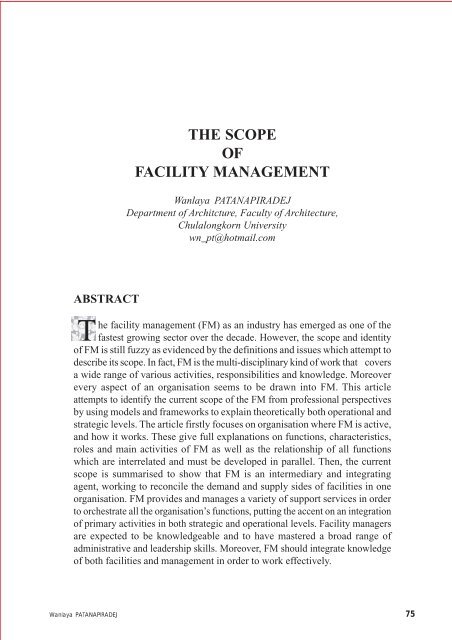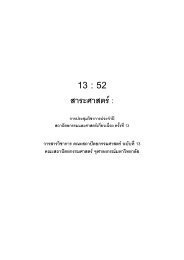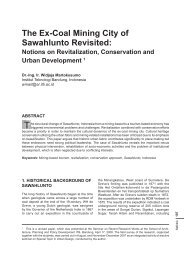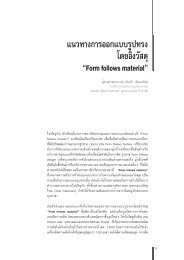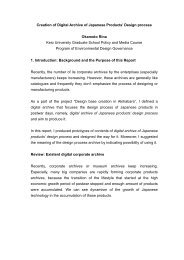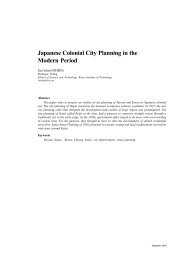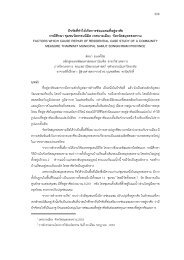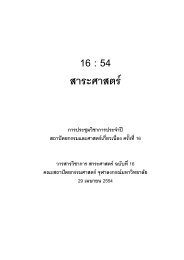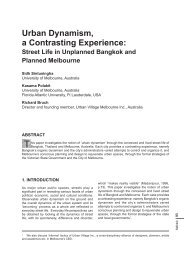THE SCOPE OF FACILITY MANAGEMENT - Faculty of Architecture
THE SCOPE OF FACILITY MANAGEMENT - Faculty of Architecture
THE SCOPE OF FACILITY MANAGEMENT - Faculty of Architecture
Create successful ePaper yourself
Turn your PDF publications into a flip-book with our unique Google optimized e-Paper software.
<strong>THE</strong> <strong>SCOPE</strong><strong>OF</strong><strong>FACILITY</strong> <strong>MANAGEMENT</strong>Wanlaya PATANAPIRADEJDepartment <strong>of</strong> Architcture, <strong>Faculty</strong> <strong>of</strong> <strong>Architecture</strong>,Chulalongkorn Universitywn_pt@hotmail.comABSTRACTThe facility management (FM) as an industry has emerged as one <strong>of</strong> thefastest growing sector over the decade. However, the scope and identity<strong>of</strong> FM is still fuzzy as evidenced by the definitions and issues which attempt todescribe its scope. In fact, FM is the multi-disciplinary kind <strong>of</strong> work that coversa wide range <strong>of</strong> various activities, responsibilities and knowledge. Moreoverevery aspect <strong>of</strong> an organisation seems to be drawn into FM. This articleattempts to identify the current scope <strong>of</strong> the FM from pr<strong>of</strong>essional perspectivesby using models and frameworks to explain theoretically both operational andstrategic levels. The article firstly focuses on organisation where FM is active,and how it works. These give full explanations on functions, characteristics,roles and main activities <strong>of</strong> FM as well as the relationship <strong>of</strong> all functionswhich are interrelated and must be developed in parallel. Then, the currentscope is summarised to show that FM is an intermediary and integratingagent, working to reconcile the demand and supply sides <strong>of</strong> facilities in oneorganisation. FM provides and manages a variety <strong>of</strong> support services in orderto orchestrate all the organisation’s functions, putting the accent on an integration<strong>of</strong> primary activities in both strategic and operational levels. Facility managersare expected to be knowledgeable and to have mastered a broad range <strong>of</strong>administrative and leadership skills. Moreover, FM should integrate knowledge<strong>of</strong> both facilities and management in order to work effectively.Wanlaya PATANAPIRADEJ75
Furthermore, the possible direction for future scope <strong>of</strong> FM which will need t<strong>of</strong>ind new strategies and regimes is proposed. The article suggests newdefinitions <strong>of</strong> workplaces which, from FM perspectives, can develop with moreimaginative views <strong>of</strong> the resources it has in hand. FM can extend the scope <strong>of</strong>its creative activity and can contribute in new ways to the organisation’ssuccess. The other view on FM’s future scope may be shaped by possibledirections <strong>of</strong> change in the future. The article also covers the scope <strong>of</strong> FM inThailand which has a uniqueness resulting from effect by Thai culture andconcludes with the current scope <strong>of</strong> FM in Thailand.Keysword : Facility management, scope, organisation, integrating FMINTRODUCTIONIn the final decade <strong>of</strong> the last millennium, the facility management (FM)industry emerged as one <strong>of</strong> the fastest growing sectors (Reeves, 1999).Nowadays, the importance <strong>of</strong> FM is readily acknowledged in many companieswhich recognise the necessity <strong>of</strong> properly managing elaborate and expensivesupport facilities (Kincaid, 1994). The tasks are multi-disciplinary and cover awide range <strong>of</strong> activities, responsibilities, and knowledge, because everyaspect <strong>of</strong> an organisation will come under the purview <strong>of</strong> FM.The IFMA model <strong>of</strong> a triangle <strong>of</strong> ‘Ps’ sums up facility management concernsin today’s work place: people, process and place. These three factors areinterdependent and have direct reciprocal relationships. As Armstrong (1982)pointed out, “we know there is a need to manage the physical environment inconcert with people and job processes.” FM finds management solutions bypositioning itself at the intersection <strong>of</strong> these three factors (Figure 1). Thisstrategy makes sense, since people, process and place are the three mainfactors <strong>of</strong> organisations, and FM involves the whole organisation. Theposition <strong>of</strong> FM at the centre implies enhanced cooperation among the keyfactors in any organisation. However, FM is most active with factors relatingto place.76 <strong>THE</strong> <strong>SCOPE</strong> <strong>OF</strong> <strong>FACILITY</strong> <strong>MANAGEMENT</strong>
Figure 1: Triangle <strong>of</strong> ‘Ps’ and FM(Source: IFMA).Successful FM leads to work placeswhich better support the flow <strong>of</strong>productive processes while addingvalue and reducing costs. The scope,range <strong>of</strong> services, activities, responsibilities,skills and knowledge <strong>of</strong>facility management are all intendedto better integrate existing organisationalfactors. This essay describesthe current scope <strong>of</strong> the discipline atboth operational and strategic levels.The future scope <strong>of</strong> FM is alsoconsidered, taking into accountorganisational factors, currentconditions, and the impact <strong>of</strong> futureinnovation and change.<strong>THE</strong> CURRENT <strong>SCOPE</strong> <strong>OF</strong> FMHow FM works in an organisationThe current scope <strong>of</strong> FM is made clearin the framework suggested byKincaid (1994), which describesmany aspects <strong>of</strong> managementpractice. Kincaid sees FM as asupport role or service, part <strong>of</strong> theorganisation’s non-core business(supply side), and serving the needs<strong>of</strong> primary activities or core business(demand side). The function <strong>of</strong> FMis to reconcile, through time, thesedemand and supply aspects in theorganization. In the IFMA model, FMworks in the area <strong>of</strong> place, but withobligations to support the needs <strong>of</strong> thepeople and processes associated withthose places.Figure 2: Relationships among place, people,processes and FM in an organisation.(Source: adapted from the Triangle <strong>of</strong> ‘Ps’,IFMA)Wanlaya PATANAPIRADEJ77
The facility manager, with place as the central focus <strong>of</strong> his or her field <strong>of</strong>concerns, has two key roles. The first involves using the organisation’s capitalresources, especially property, physical plant and facilities. The second meansmanaging the organisation’s support services, both routinely and in emergencies.These two management roles integrate three main activities:1. Property management (real estate);2. Property operations and maintenance;3. Office administration.The operational and strategic levels <strong>of</strong> FMBarrett and Owen (1992) divide FM into two broad categories by functionanalysis:• Operational or implementation functions• Management functionsOperational or Implementation functionsOperational activities are day-to-day or routine support functions involvingworkers. Activities include the operation and upkeep <strong>of</strong> overall physicalresources in order to maintain the good condition and appearance <strong>of</strong> the workplace, to add value to physical resources, and to provide a safe and healthyenvironment for the organisation’s primary activities. Tasks at this level havea relatively short-term scope, and involve specific processes, simple anddirect, such as cleaning, replacing, repairing, redecorating, grounds-keepingetc. Secure arrangements for such routine operations and services are thebedrock <strong>of</strong> good FM practice (Nutt, 2002).Management functionsManagement functions can be distinguished at tactical and strategic levels.Tactics are action plans involving routine, specific and short-term preventiveor managerial operations. (Johnson & Scholes, 2002). Such activities, whichare best kept simple, focus, for example, on routine actions such as safetyprocedures for prevention or proper use and care <strong>of</strong> maintenance resources.Activities on this level support responsible behavior in the workplace and thecontinuity <strong>of</strong> working conditions.78 <strong>THE</strong> <strong>SCOPE</strong> <strong>OF</strong> <strong>FACILITY</strong> <strong>MANAGEMENT</strong>
At the strategic level there is consultation and non-routine planning aimed atmaking the best, long-term use <strong>of</strong> the organisation’s physical resources andoverall facilities. Johnson & Scholes (2002) see management strategy asdealing with the complexities <strong>of</strong> ambiguous, non-routine situations which canaffect the direction and future <strong>of</strong> the whole organisation. Strategic decisionsdemand an integrated approach since the entire organisation should move, inunison, in the same development direction. Tactical and operational levelsdepend on policy direction from strategic planners. The field <strong>of</strong> tasksenvisioned by strategists appears sophisticated and complex, because manyprocesses and people are involved and many aspects <strong>of</strong> the organisation mustbe orchestrated.Strategy is needed to cope with the prospect <strong>of</strong> an unknown and changingfuture since it may generally be said that “the further we look ahead, the moreuncertain we become” (Nutt, 2002-03). Although long term forecasting canonly hypothesise about the future, strategic planning aims to reduceuncertainty by choosing a preferred path and a reasonable long term directionfor the development <strong>of</strong> the organisation (Nutt, 2002)Strategic overviews have two objectives (Nutt, 2002-03):• Negative aims (Reactive): to reduce risk and constraint, and to avoidfailure and undesirable outcomes;• Positive aims (Proactive): to increase opportunities and advantages;to achieve success; to increase value; and to achieve desirableoutcomes.Figure 3: How FM is carried out (Source: CEM)Wanlaya PATANAPIRADEJ79
Kincaid (1994) concluded that these three disparate sets <strong>of</strong> complementaryactivities can be effectively integrated only with an impressive array <strong>of</strong>dramatically different skills, a vast information base, and a full managementrange which covers everything from routine operations to long-term strategy.Kincaid (1996) identified three distinctive characteristics <strong>of</strong> FM as follows:1. Facility management takes a support role within an organisation, orprovides a support service to the organisation.2. FM must link strategically, tactically and operationally to othersupport activities and primary activities in order to create value.3. The managers must be reasonably knowledgeable in terms <strong>of</strong>facilities and managementIntegrating FM in an organisationFM activities are relevant to the various aspects and dimensions <strong>of</strong> organisations.This means that managers need to have an intimate understanding <strong>of</strong>how the organisation works (Kincaid, 1994). To create and implement FMstrategy, planners need to understand all dimensions <strong>of</strong> the organisation. Fourbasic dimensions can be posited (Nutt, 2002-03):1. The purpose <strong>of</strong> the organisation, its vision, mission, objectives, corecompetency and goals.2. The processes <strong>of</strong> work, operations and projects.3. The environmental context, organisational behaviour, culture andmarket.4. The product(s), infrastructure, property and facilities.A clear understanding helps shape appropriate FM strategy and plans, andsupports the use <strong>of</strong> the processes and operations most suited to each organisationin its existing property and facilities.Johnson & Scholes (2002) emphasise that each aspect in itself is important,but none is adequate alone. The manager who aspires to manage or influencestrategy must be able to see a larger picture. A perception <strong>of</strong> the whole ratherthan just the parts is critical.Wanlaya PATANAPIRADEJ81
Organisational culture, technological change, and global competition inevitablyaffect FM, and an integrated view from a business perspective is indispensable(Then, 1999).The range <strong>of</strong> FM knowledgeKincaid (1994) stated that FM is not simply the practice <strong>of</strong> managing thevarious support services in an organisation. Facilities management shouldintegrate knowledge <strong>of</strong> both facilities and management in order to workeffectively. Concerns about support services for operations and activities shouldbe driven by appropriate, relevant and adequate knowledge <strong>of</strong> facilities andmanagement.Figure 5: Integrated FM in practice, four components (Source: Kincaid, 1994)82 <strong>THE</strong> <strong>SCOPE</strong> <strong>OF</strong> <strong>FACILITY</strong> <strong>MANAGEMENT</strong>
Figure 8: FM service delivery (Source: adapted from Chotipanich, 2002)Another possible direction to extend FM’s scope is illustrated in Figure 8.From the FM point <strong>of</strong> view, an organisation’s first achievements range fromthree sets <strong>of</strong> bedrock FM improvements, i.e. workable conditions, excellentconditions and cost reduction. Improvements in these areas are seen mostly inthe place factor. Very soon, however, two other important factors, i.e. peopleand processes in the workplace, must be addressed. Service delivery, with theprogression <strong>of</strong> people and process factors, is assessed as it moves from betterto best performance and, finally to best in its league. Making people the mainfocus could be the most revolutionary route to the future (Nutt & McLennan,2000), a route which FM is designed to support. FM improves people andprocesses by supporting improved productivity in a healthy, safe and humaneworkplace. To be successful, FM must be aware <strong>of</strong> people’s need for awork-life balance. FM must also accurately perceive the relationship betweenthe organisation, in all its aspects, and the local community. This is FM’sintegrative work. It encompasses overall aspects <strong>of</strong> the whole organisation.The other view <strong>of</strong> FM’s future scope may be shaped by possible directions <strong>of</strong>change in the future. This article will focus on new definitions <strong>of</strong> workplaces.In today’s business environment is understood that work is changing. Theworkplace is influenced greatly by employee behaviour and expectations, andby new work processes. Technology is a dominant factor as business becomesincreasingly dependent, both financially and operationally, on informationexchange and knowledge sharing. (Reeves, 1999). Change driven byWanlaya PATANAPIRADEJ85
information technology (IT) directly and globally affects organisations.Workplaces are increasingly seen as transient nodes in global networks(Grimshaw, 2002).Nutt & McLennan (2000) suggest that the trend in work practices is towardmore responsive working arrangements, global dispersal <strong>of</strong> work, and newmulti-venue and multi-location ways <strong>of</strong> working, all with increased relianceon subcontracting and partnering. These developments contribute toward‘flexible working,’ i.e. work that is ‘time flexible’, ‘place flexible’ and‘location variable’. Changing work processes affect relationships with othercomponents; ‘work’ is no longer a place – it is an activity that can beconducted anywhere. New workplaces will have a tendency to be moreflexible, more people centered and more responsive (Grimshaw, 2002).Consequently, it is clear that business requirements for workspaces will changein terms <strong>of</strong> quantity, quality, location, diversity and functionality. This, in turn,places greater and more varied demands on those responsible for the provisionand management <strong>of</strong> facilities (McGregor, 1999). As a result, facilities havenew and wide ranging characteristics. New patterns <strong>of</strong> support services willalso emerge, along with an extended scope <strong>of</strong> services, operational andmanagement regimes, and related, knowledge based development.Despite these changes, the concept <strong>of</strong> FM as an intermediary agent, i.e.integrated FM, is still clear. FM still works to reconcile the demand and supplysides. To support this new workplace, however, the scope <strong>of</strong> FM activities andservices, at operational levels, might extended and become more complex. Anew range <strong>of</strong> facilities and services are needed for the increasingly flexibleworkplace, for people’s rapidly changing requirements. Services may requiremore agile and real-time activity.The strategic level cannot rely only upon integrated and well-planned strategicwork. To tackle future change and new work processes, changing workplacesand new technology, FM should extend its scope to include this innovativework activity.All in all, the future scope <strong>of</strong> FM can be based on three possible directions.1. To shift from the facilities’ cost centre to the business unit’s pr<strong>of</strong>itcentre, viewing facility as a tool to generate income. (strategic work)2. To amalgamate three main factors in an organisation i.e. place,people and processes with the sense <strong>of</strong> a more effectively planned,on-going integration <strong>of</strong> necessary facilities and support services.(integrative work)86 <strong>THE</strong> <strong>SCOPE</strong> <strong>OF</strong> <strong>FACILITY</strong> <strong>MANAGEMENT</strong>
3. To tackle future changes within organisations by using innovativeapproaches in facility services and management. (innovative work)<strong>THE</strong> <strong>SCOPE</strong> <strong>OF</strong> FM IN THAILANDA study by Chotipanich (2002) <strong>of</strong> FM service supply and practice in Thailandfound some interesting outcomes. FM services are mostly involved inbuilding operations, maintenance and routine services. Strategic FM,planning and consulting services are being provided at minimum levels.At the same time, the development <strong>of</strong> FM practice in Thailand is hindered bythe attitudes <strong>of</strong> building owners and senior executives who regard their ownphysical resources as risky, burdensome obstacles to daily work. Physicalresources have a low priority in most organisations. Decision-makers take ashort-term view <strong>of</strong> investments in construction and set close limits on budgetsfor maintenance and operating costs.Some characteristics <strong>of</strong> Thai culture naturally affect the shape and uniqueness<strong>of</strong> FM in Thailand. For example, Thai people tend to tolerate occasionalinterruptions and system breakdowns very patiently.According to the Chotipanich study, some Thai companies already view FMas a business tool to generate income and actively make use <strong>of</strong> their physicalresources for this purpose. Nevertheless, the overriding idea in doing so stilltends to be remedial, as, for example, to help the organisation compensate forthe building’s operating costs.The development and scope <strong>of</strong> FM in Thailand, therefore, remains pretty muchin its infancy, as described in Figure 9. Service delivery is still focused mostlyat the level <strong>of</strong> the place factor. FM practice on this level is very acceptable forThai people, who feel pride in seeing their physical resources in excellentcondition and find satisfaction simply in knowing they are cost-effective.Wanlaya PATANAPIRADEJ87
Figure 9: Scope <strong>of</strong> FM in Thailand (Source: adapted from Chotipanich, 2002)To conclude, most FM activities in Thai society appear to take place onoperational levels. Fully integrated FM, strategic FM and innovative FM arestill very foreign concepts. Many facility managers are constrained by theirown business culture from trying to imagine their mission in a broader scope.Nor have many senior executives in local organisations been persuaded thatthey really need to invest in fully integrated FM activities for their companies.In short, FM practice in Thailand has been adapted and implemented in linewith constraints <strong>of</strong> local knowledge, technology, investment and culturalpreferences (Chotipanich, 2002).CONCLUSIONAs a rule, attempting to forecast more than a few years ahead is risky business.All that we can do is to make an educated guess at the directions <strong>of</strong> change(Nutt & McLennan, 2000). Whatever direction the changing world takes, theneed to evolve always comes with complexity and hardship. Even so, facilitymanagers have reason to view challenges optimistically, as new opportunities.Roles and activities in more integrated FM practice will gradually expand.Wherever facility management is implemented, the aim remains the same.The long-term logic <strong>of</strong> integrated FM will support its broader future role inorganisations, facilitating smooth exchanges between supply and demand sides.88 <strong>THE</strong> <strong>SCOPE</strong> <strong>OF</strong> <strong>FACILITY</strong> <strong>MANAGEMENT</strong>
Thus, the future scope <strong>of</strong> FM services, in one view, will increase – ‘wider stillwider’ – in the view <strong>of</strong> Oliver John, Chief Executive <strong>of</strong> Citex, or, in thecontrasting view <strong>of</strong> Fred Guscott, Chairman <strong>of</strong> the <strong>Faculty</strong> <strong>of</strong> FacilityManagement, RICS, will –‘do less better’. Both viewpoints are acceptable.The scope <strong>of</strong> FM operations and services will expand overall, under a morecoherent and comprehensive umbrella title – IF: Infrastructure and Facilities.This means the work will be better targeted and more specific in its areas <strong>of</strong>application, with a perhaps more realistic scope, and more consistentperformance (Nutt, 2002).REFERENCESArmstrong, D. (1982), ‘Is facility management a fad? Why all the hoopla now?’, Interiors,Dear Dare series, June.Barrett, P S.& Owen, D D. (1992), ‘The Outsourcing Balance: Is There an Optimum?’,Facilities Management Research Directions (ed Peter Barrett) University <strong>of</strong> Salford.Chotipanich, S. (2002), ‘Principles and Concepts <strong>of</strong> Facility Management in Thailand’, notefor presentation in FM Thailand Seminar 2002, Chulalongkorn University, BangkokCollege <strong>of</strong> Estate Management (2000) FM, coursenotes. UK: CEM.Grimshaw, B. (2002), FEM1.6; Pr<strong>of</strong>essional Development in FM, coursenotes. UK: UCL(Not publish)International Facility Management Association (IFMA): IFMAJohnson, G. & Scholes, K. (2002), ‘Exploring Corporate Strategy’, 6th edition, ParsonEducation Limited., EnglandKincaid, D. (1996) In Chotipanich, S. (2002) ‘Principles and Concepts <strong>of</strong> Facility Managementin Thailand’, note for presentation in FM Thailand Seminar 2002, ChulalongkornUniversity, BangkokKincaid, D. (1994), ‘Integrated Facility Management. Facilities. Vol. 12, no. 8, pp.20-23.McGregor, W. (1999), ‘The Future <strong>of</strong> Workspace Management’, In: McLennan, P., Nutt, B.,and Kincaid, D., (ed) Future in Property and Facility Management, 24-25 June,fm exchange, University College London, London, pp.63.Nutt, B. (2002), ‘The Purpose and Value <strong>of</strong> FM’, note for presentation in FM ThailandSeminar 2002, Chulalongkorn University, BangkokWanlaya PATANAPIRADEJ89
Nutt, B. (2002-03), FEM1.4; Life History <strong>of</strong> Property, Facilities and Services, coursenotes.UK : UCL (Not publish)Nutt, B. and McLennan, p. (2000), Facilities Management risks & Opportunities,Blackwell Science Ltd., LondonReeves, R. (1999),’Repositioning FM : Meeting the Business Imperatives for FundamentalChange’, In : McLennan, P., Nutt, B., and Kincaid, D., (ed) Future in Property andFacility Management, 24-25 June, fm exchange, University College London,London, pp.19.Then, S S. (1999), An Integrated Resource Management View <strong>of</strong> Facilities Management.Facilities. Vol. 17, no. 12/13, pp.462-469.Thompson, T. (1990), The Essence <strong>of</strong> Facilities Management. Facilities. Vol. 8, no. 8, pp.8-12.90 <strong>THE</strong> <strong>SCOPE</strong> <strong>OF</strong> <strong>FACILITY</strong> <strong>MANAGEMENT</strong>


